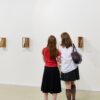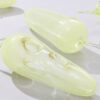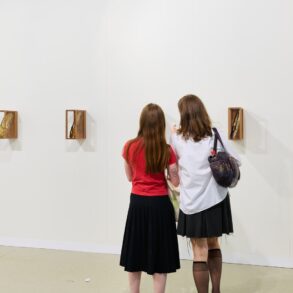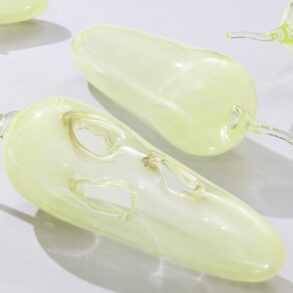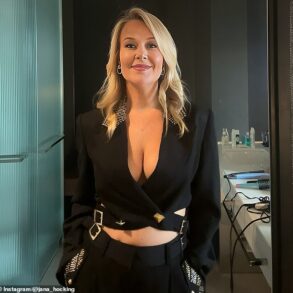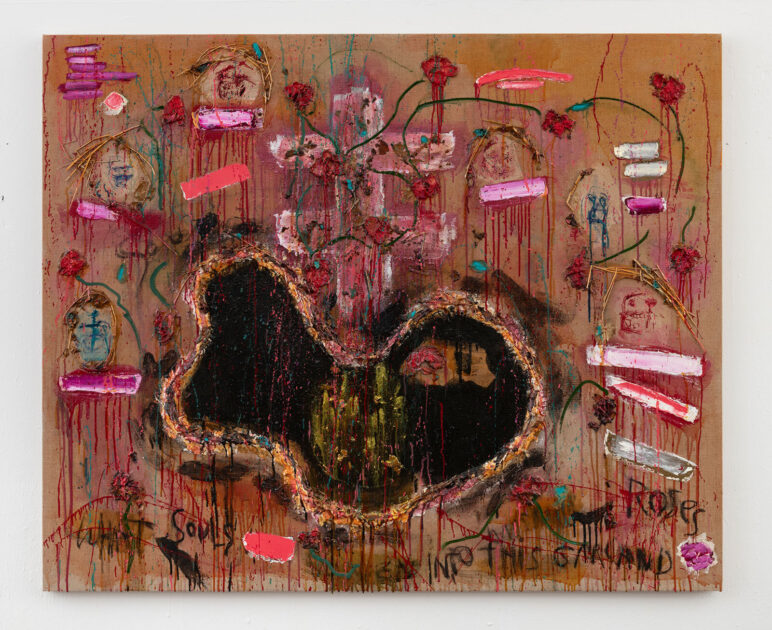
KD What made Heart On a breakthrough?
JS I was using the grid to make squares, filling in the grids, making multi-paneled works. Heart On was addressing the feminine and sexuality. I was just beginning to get romantically involved with a woman. I was bringing together images of circles, hearts, and breasts. And I turned back to the materials I had stopped using in the ’60s for this painting. It was about a female sensibility, the feelings of a woman and of sexuality. Larry Fink and I sat in my studio in Martin’s Creek, probably smoking a joint, and titled the painting Heart On, a very amusing title.
KD While at Rutgers, you made a plaster angel sculpture adorned with fringe and plastic flowers, and a series of altar paintings. Did this style come out of your experience as a woman?
JS This was before any female sensibility discussion, but that feeling was part of my being and my art early on. In ’64, ’65, ’66, there were things going on in my life that are reflected in the work. Robert Morris was my sculpture teacher. We’re talking about Minimalism. For me, the angel was a rejection of the minimal. The angel was, obviously, like, Come on, Morris, I’m not going to sit and make a gray box like everyone else in the class. And I remember that he was astounded by my angel.
KD Do you ever think about your work in relation to sentimentality or kitsch? Like a valentine or a plaster saint?
JS It’s not kitsch; it’s humor. It’s my sensibility. My work sometimes has humor on top of everything else. The altar paintings were quite serious. When I wrote my MFA thesis, I said that my work was my religion. This was my altar, where I go to worship, humor and all.
KD I’ve seen your work referred to as maximalist before. Is that title something you embrace?
JS You could call me a maximalist in the sense that my work uses lots of materials; it’s psychological; it often has content beyond the field or the stroke; and it packs a lot of information into one painting.
KD Like your combination of humor with serious content. Is this tension something conscious or something intuitive to you as you work in the studio?
JS In one painting, there can be humor and heavy emotion, like in Love’s Deep Grapes (1984). That was the first time I used plastic grapes in a painting, which is, to me, a humorous thing to do; and yet it was a deep, dark painting, quoting Virgil, made while I was having an affair with my psychiatrist! It was a wild, crazy, stupid, and painful thing to do—not the painting, the affair—and of course I was making art about it.
I had this extraordinary experience with a recent painting, Roses & Souls (2024). A writer asked if I was doing any political paintings these days. I said, “I’m not. I have no thoughts about doing that.” The very next painting began with small ink drawings of screaming faces or souls, which are related to Journey of the Souls (1993). While adding the faces, the souls and dried roses with their stems surrounding the faces, and a garland weaving around the painting, I didn’t know exactly what this painting was about.
Then an extraordinary thing happened to me. As I’m painting, I walked over to the bookshelf and pulled out a small paperback book, the Paradiso by Dante, and found a page that I marked forty years ago. A note to the translation says: “what flowering plants: What souls are woven into this garland: Are in this company of souls that wreath Beatrice round.” And there’s another spot I underlined: “just so, those sempiternal roses wove / their turning garland round us, and the outer / answered the inner with the voice of love.” And here I am, making a painting described by Dante.
KD There is a sense of magic in the chance encounter with this poetry that’s been with you for decades. Dante mentions “the voice of love,” and I wanted to ask you about the role of love in your work. It often appears in your titles, like Love Your Bones (1970–71), Love’s Pale Grapes (1982), Love’s Deep Grapes (1984), Motherlove (1999), and your Love, Mom (2017–) series.
JS What can I say about love? It’s a part of our lives. It’s a part of the practice. It’s a part of everything.
This post was originally published on this site be sure to check out more of their content

